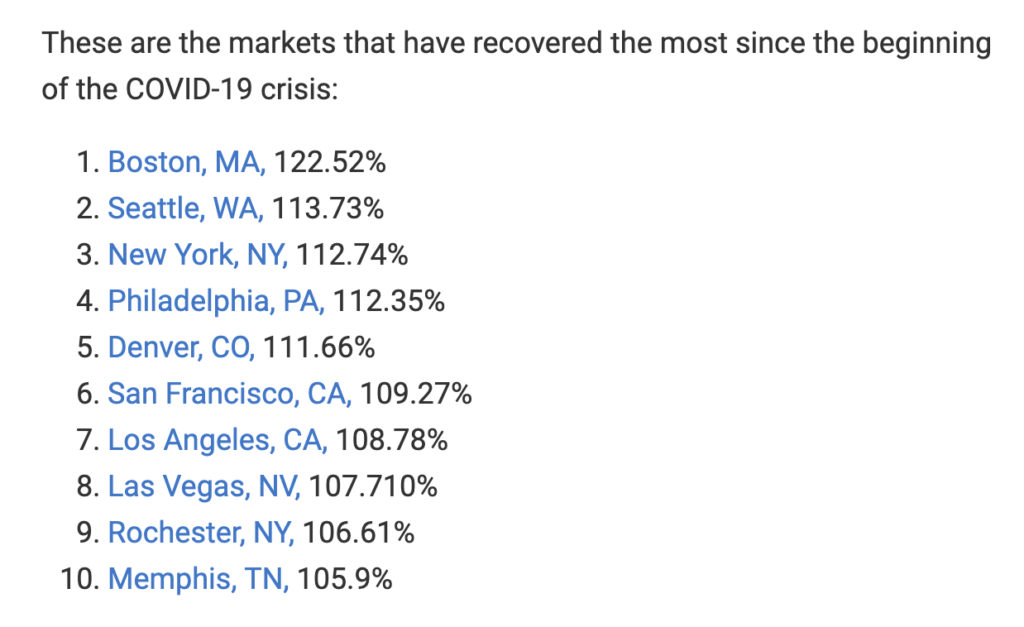Inman News
Boston, New York City and Philadelphia have exceeded pre-COVID market pace thanks to rising interest in the suburban listings, according to realtor.com
Higher temperatures aren’t the only thing summer has ushered in. According to a realtor.com market report released on Monday, median listing prices and median home values have heated up as buyers reignite their home search journey.
Median listing prices grew 9 percent year-over-year in July, as the median home price skyrocketed to an all-time high of $349,000. At the same time, inventory and interest rates remained near historical lows — creating an uber-competitive summer homebuying season, especially in the Northeast.
“Housing tends to be immune from economic downturns and slowdowns,” realtor.com Director of Economic Research Javier Vivas said while excluding the past recession. “Right now we’re seeing markets recover faster where they’re able to contain the virus better.”
“Markets with strong technology sectors have been more resilient,” Vivas added.
More than 50 percent of the nation’s largest metros have rebounded from lockdown lows, with annual gains in median home asking prices, new online listings, days on market and online home searches. Metros with a score of 100 percent have rebounded to its January pace, while metros with a score above 100 percent are outperforming its January pace.

Credit: realtor.com
Boston (122.52 percent), Seattle (113.73 percent), New York City (112.74 percent), Philadelphia (112.35 percent) and Denver (111.66 percent) metropolitan areas led the way, with each market performing 22 to 11 percent better across all market metrics than it did in January.
“Boston, a finance, tech, and higher education hub, earned the No. 1 spot on our recovery list, with a median home price of $675,050,” Vivas explained. “But the metro, like many others across the country, has seen a huge shift in what buyers want.”
“The housing markets in less expensive, smaller cities as well as the suburbs and farther out towns where buyers can get more square footage for their money, the easier to social distance in, are more in demand than high-rise condos and apartments in the nation’s largest, most expensive city centers,” he added. “People are looking for larger homes and also looking for value.”
Expensive townhomes and condominiums within Boston’s city center are languishing on the market, while mansions in Boston’s suburbs are being snapped up as soon as they hit the market.
“Sellers would have had to discount [these places] to sell” before the pandemic, says local real estate agent Gary Kaufman of Keller Williams Realty told realtor.com. “Now these properties are selling at full price.”
The same is happening on the West Coast, the report said, with median listing prices in Seattle, Denver, San Francisco and Los Angeles’ suburbs ranging between $500,000 to $1 million.
“Right now, everything that residents love most about San Francisco and other cities—clubs, cultural venues, and events, street fairs, restaurants, the ‘rush’ of social life in the city, being able to walk to work—has pretty much disappeared,” Compass Chief Market Analyst Patrick Carlisle said of the decreasing popularity of urban listings. “What remains is the sense of feeling locked in, being more exposed to the virus, and trying to avoid people whenever they venture outside.”
As the summer homebuying season continues to ramp up, Vivas said smaller metros including Las Vegas (107.71 percent), Rochester (106.61 percent) and Memphis (105.9 percent) are on track to experience an influx of buyer interest from across the country.
“You’ve got people priced out of California, Colorado, Washington state, and even Arizona now,” Vivas said. “They’re looking for cheaper mortgages and a larger space for less money.”
“This helps explain why Vegas, which was one of the poster children of everything that went wrong in the past recession, has rebounded so quickly,” he added.
